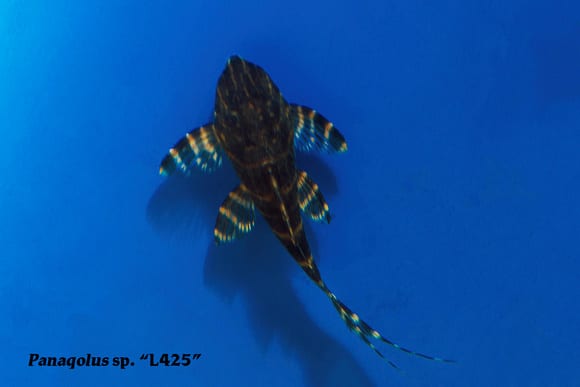You Are What You Eat
You Are What You Eat
It’s no secret that what you eat has a pretty large effect on you, but when looked at through an ecological and evolutionary context, the effects of diet can be positively speciating! As animals adapt to eating a new food source, their bodies change to become better at both gathering the food and digesting it. These changes can cause branches and radiations on the tree of life, and new and exciting species arise frequently (on an evolutionary timescale) based on how they harness energy from the earth. Fish are no exception. Today, we will take a closer look at 3 unique catfish species, hailing from groups with dietary speciation events in their recent history. These include Chaetostoma sp. “L457”, Panaqolus sp. “L425”, and Hassar orestis.
Scientific NameChaetostoma sp. “L457”
Common NamePitbull Pleco
Temperature / pH68 to 73°F / 6.8 to 7.8 pH
Native LocationPeru
Preferred DietOmnivorous
Chaetostoma is a genus of loricariid catfish that thrives on an omnivorous diet. The switch from complete herbivorism to omnivorism requires less intestinal length, where larger intestines are required for the more intensive digestion of chlorophyll and other hard-to-digest plant compounds. Thus, they can maintain a smaller (and more manageable for the aquarist) body size, which also allows them to be kept in unheated aquaria. L475, or “Pitbull Pleco” reaches only about 5 inches in length, has a flattened body with a rounded snout, dark brown coloration with light-colored spots and striped covering the face and body. Though they don’t subsist entirely on algae, these rubbernose plecos do a mighty fine job cleaning surfaces of smaller tanks. Additionally, they should be fed prepared veggies like blanched spinach or zucchini, and regular offerings of live and frozen invertebrates like bloodworm and brine. Found primarily in the Alejandro drainage of Peru, this pleco does best in river-bottom-like setups with sandy substrate, stacks of rounded stones, and slate caves. Quite peaceful alongside other species, they can be kept in any South American community tank, with small cyprinids, small characids, and even corydoras. Waters should be maintained with temperatures between 68 and 73°F, pH of 6.8 to 7.8, and hardness of 142 to 445 ppm.
Scientific NamePanaqolus sp. “L425”
Common NameLyretail Clown Pleco
Temperature / pH78 to 82°F / 5.5 to 7.5 pH
Native LocationPeru
Preferred DietWood
Another oddball of the loricariid family, Panaqolus is one of the few groups of vertebrates that consume wood. Their highly-angles jaws, and spoon-shaped teeth allow them to chisel wood, and many scientists believe they possess gut microbes to allow them to actually digest the wood (a VERY difficult venture!). However, many others believe that they are eating the wood to consume and digest algae, and invertebrates on the material. Panaqolus sp. “L425” is one of the seven currently recognized species in this group. More commonly known as “Lyretail Clown Plecos”, they reach a maximum of about 12 inches and are brown with thin, zebra-like striping. Inhabiting fast-flowing streams and rivers of Peru, they prefer habitats with sandy substrate and plenty of hiding places like rocks, PVC pipe, and of course, wood. They require an ample supply of clean bogwood, which will serve as part of their food source, but they should also be provided with fresh vegetables like zucchini, carrots, and potato, and algae tabs. Somewhat territorial to conspecifics, they should be kept as single specimens except for in large tanks with many distinct burrows. Otherwise, they can be kept alongside most peaceful non-bottom-dwelling community fish. Tank waters should be maintained with temperatures of 78 to 82°F, pH between 5.5 and 7.5, and hardness of 36 to 268 ppm.
Scientific NameHassar orestis
Common NameBlack Top Mouse Cat
Temperature / pH72 to 80°F / 6.0 to 7.5 pH
Native LocationCoastal South America
Preferred DietSmall invertebrates
Popular in the aquarium for their adventurous behaviors and peaceful dispositions, catfish from the family Doradidae are known as “Thorny Catfish” for bony lumps along their lateral line. Additionally, catfish in this group are referred to as “Talking Catfish” for defensive squeaking sounds they make by vibrating their swim bladders. Hassar orestis is one such talking catfish found where their food source of invertebrates and plant residues is most plentiful: in slow and standing waters among roots and submerged vegetation throughout coastal mangroves of South America. If an aggregation is stumbled upon by a potential predator, they produce defensive noises and thumps to scare them off. In captivity, these “Black Top Mouse Catfish” should have plenty of plant cover to reside within, low lighting, wooden and rocky hideouts, and good filtration. Reaching about 7 inches, they have pale underbellies and black backs, black-spotted dorsal fins, long snouts, and long whiskers. Generally peaceful and gregarious by nature, they should be kept in conspecific groups of 3 or more in community tanks alongside small characins like tetras and hatchet fish. Captive diets should consist of predominantly small frozen foods like bloodworm and daphnia, and small granular foods. Tank waters are best maintained with temperatures between 72 to 80°F, pH of 6.0 to 7.5, and hardness between 89 and 356 ppm.
You are what you eat couldn’t be a more spot-on phrase. While eating a bag of cheetos on the couch may not have long-lasting effects on the phenotypes of your descendants, we could use this catfish speciation model for a fun thought experiment: what would happen if for thousands of years there was a completely isolated group of vegetarian humans with no outbreeding? Hmmm…maybe we should just stick to fish.


